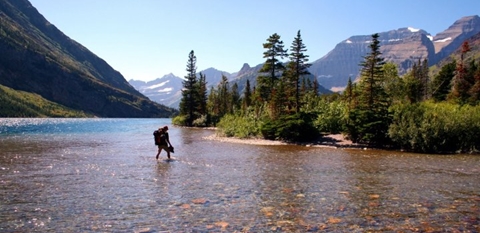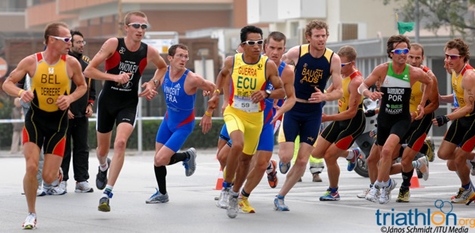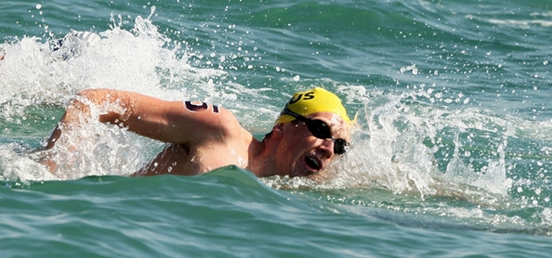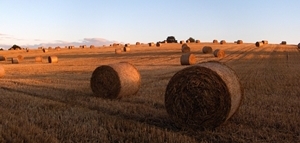Muscle Cramps are Symptoms of Improper Hydration and/or Electrolyte Imbalance.
Did you ever get a cramp half way into a bike ride or run? Its a horrible feeling isnt it? Not only does it hurt, one often wonders if they will even make it home! Muscle cramps are often symptoms of improper hydration and/or electrolyte imbalance. Whether you are a beginning or elite athlete, proper hydration and electrolyte consumption are essential for health and performance. Below we will discuss electrolytes (what are they?) and the role they play along with proper fluid replacement in athletic performance. The human body has evolved elaborate mechanisms to monitor and maintain water and electrolyte balance. It does this because these are so critical to function. Humans can survive for days without food, but can die within 3 days without water.
Lets look into the terms and the important issues more closely. The term Body water refers to all of the water content of the human body. A significant fraction of the human body is water. The total amount of water in a 70 kilograms human (154 lbs) is approximately 40 liters, averaging 57 percent of his total body weight (Guyton's Textbook of Medical Physiology). So you are more water than anything else!
Key Electrolytes in the Body
Body fluids (water) contain electrolytes. Electrolytes are salts of various types each of which play a critical role in physiology (function) and in athletic performance. The best known salt is so called table salt which is usually sodium chloride (NaCl). When NaCl is put into water the Na and Cl atoms separate into positive and negative ions: Na+ and Cl-. Note that the + or sign in the superscript denotes that these are positive (+) or negative (-) ions in solution. These charged ions permit water to conduct electricity hence the name electro-lytes. These electrical properties are critically important for such things as heart blood pumping, nerve conduction and skeletal muscle contraction; all things important to the athlete. See also Potassium Natural Food Sources for Optimum Health and Performance
Because of this critical need for proper hydration and appropriate electrolyte balance, the body has a myriad of redundant systems that all function to monitor and maintain hydration and electrolyte balance. For example, the kidneys monitor blood levels and work to keep electrolyte levels in the blood constant. Hormones (such as antidiuretic hormone (ADH), aldosterone and parathyroid hormone) all regulate electrolyte balance. The body performs delicate balancing acts to keep water and electrolyte levels optimal. If blood sodium levels drop too low, the kidneys are stimulated to produce more urine. This restores balance by lowering the amount of water in the blood. If sodium levels get too high, thirst develops, stimulating the person to drink. Hormones secreted in response to thirst cause the kidneys to produce less urine and conserve water. During intense exercise and sweating these systems are taxed and the endurance athlete must sometimes anticipate where the system (body) is heading in terms of water and electrolyte status in order to avoid problems. The take home message here is: If you are thirsty drink water! Your body is talking to you.
Lets quickly review some of the main key electrolytes in the body. The recommended daily dietary intake for people is shown in parentheses. Sodium (1-2 grams), calcium (1-2 grams), chloride (1 gram), magnesium (0.4 grams) and potassium (2-4 grams) are the most common electrolytes in the human body. These electrolytes are essential for heart, nerve and muscle functions. They also play an important role in keeping fluid levels normal in different body compartments. Most people get sufficient electrolytes in the foods and drinks they normally consume. However during periods of intense prolonged physical activity there may be a need for additional electrolytes. The body looses electrolytes through sweating and it is eventually important to replace them. One of the main body fluids is blood and its content reflects the required electrolyte balance.
Serum Electrolytes Levels, Sweat Rates
Serum electrolyte levels (serum is the fluid part of blood):
Sodium 3.2 grams / liter
Potassium 0.16 grams / liter
Calcium 0.1 grams / liter
Chloride 3.5 grams / liter
One can see that sodium (Na+) and chloride (Cl-) are present in by far the greatest amount in serum (blood). Potassium (K+) and calcium (Ca++) ions are important intracellular (inside cells) ions and in the case of calcium much of it is in bones. Calcium plays a crucial role in muscle contraction (heart and skeletal muscle) as well as many other functions but the body has large stable reserves (the skeletal system) and replenishment is not usually required on a short term basis.
One liter of sweat typically contains about: 1.15g Sodium, 0.23g Potassium and 1.48g Chloride. These values vary widely among individuals but will be accurate to within about +/- 50%. The actual salt lost will depend upon the sweat rate (liters per hour) and the concentration (amount) of salt in the sweat. Ideally one would know these values for oneself, but it is fairly easy to make a good guess based on knowledge of how much you sweat (little vs. a lot) and how salty your sweat is (not very or very). If you have salt stains on your clothes and your sweat stings your eyes, chances are that you have significant amounts of salt in your sweat.
Normal sweat rates can range from 0.75 to 2 Liters/hour, depending on conditions such as temperature, humidity, exertion, clothing, and the degree of heat acclimation of the athlete. A rate of one liter per hour is not uncommon for a runner or cyclist. At that rate, typical electrolyte loss rates by sweat are ~1 g/hr for sodium, and 0.2 g/hr for potassium.
For the most part your body can make up for these losses for exercise up to 1.5 - 3 hrs but beyond that (and in preparation for going beyond that time) electrolytes should be consumed (e.g. starting at about 1.5 hrs). Sport drink companies want you to believe you need them all the time but this is not really the case especially if one eats a balanced diet. For most workouts water is sufficient for the first hour or so. And may not really be needed if one is sufficiently hydrated before and takes care to drink after exercise. For intense exercise at high levels of exertion, glucose based fuel may be needed before this time but not necessarily electrolytes. Note there is often a significant psychological benefit to sipping (especially cool) water during a work out. So drinking water early and often is a good thing.
Electrolytes, Sweat and Humidity
Ever notice how you seem to seat more when it is humid? Well that is an illusion and one to remember. Sweat is the body's attempt to eliminate excess heat through evaporative cooling. When it is humid, sweat evaporation is less effective and the sweat just stays on you and drips off. So you feel sweaty. When it is very dry outside (low humidity), the sweat evaporates quickly. People can get into trouble in a dry environment because they think they don't need to drink because they "are not sweating" but they really are they just don't feel it. The same can happen on the bike when the wind helps evaporate the sweat quickly. So drink up!
Foods and Natural Sources of Electrolytes
A good natural source of electrolytes is from food. Fruit and vegetables, including canned or frozen vegetables like corn, carrots and green beans, are high in electrolytes, as are bread, milk, and fruit. Water with a small pinch of salt (1/3 tsp per liter), sugar (3-5 tsp/liter) and flour added to it will provide electrolytes and energy. See Raw Milk - Most Effective Sports Training and Recovery Drink!
A teaspoon is approximately 5 grams (5000 mg) and for sodium chloride (table salt) about ½ of this is sodium (this is an approximation as a teaspoon measures volume and grams are a measure of mass and every item has a different mass but it is close enough). Most sport drinks sodium at contain ~ 50 mg / 100 ml (0.5 g / liter). So ½ tsp in 2 liters is about the correct amount.
Electrolyte content of some foods (note 100 g is about 3.5 oz)
mg/100g Na Cl K
Milk 55 100 139
Wheat flour (whole) 2 38 290
Rice (polished, raw) 6 27 110
Potatoes 3 79 410
Carrots 50 69 311
Apricots 0.6 — 440
Dates (dried) 1 290 790
Oranges 1 3 170
Bread (whole meal) 540 860 220
Bananas 1 93 467
Homemade Recipes for Sports Drinks and Energy Electrolytes Gels
Ingredients for Homemade Sports Drinks (1 liter):
Pure organic fruit juice concentrate (200-240 ml or 8 oz)
Water or Green Tea (to 1 liter)
Salt (1/4 - 1/3 teaspoon)
Homemade Energy Electrolyte Gel:
7 tablespoons of honey)
1 teaspoons of blackstrap molasses*
1/8 tsp of table salt
*Molasses contains 1460 mg K / 100 grams but only 37 mg Na. Honey contains even less Na.
Sports Snacks:
Nuts (salted peanuts) and raisins. Raisins have carbohydrates (sugars), and potassium but little sodium. Nuts have protein, fats and sodium. So they go well together.
Bottom Line!
Rule Number One: drink when you are thirsty! The typical endurance athlete needs to consume about 0.5 1 liter per hr (20 to 40 fluid ounces) of water, especially for exercise longer than 1 hr. After about 2 hrs if the effort is to continue, one should begin consuming electrolytes, primarily sodium. This can be in the form of a food or drink with at least 250 mg of sodium per 0.5 liter (or about 100 mg per 8 ounces) again with a consumption rate as above. We have not discussed fuel for performance here and that is for another time.
It is often convenient to consume a sport electrolyte drink under these conditions. These drinks contain other electrolytes, such as potassium, magnesium and calcium in the correct quantities. Again these are needed only if you're doing a long workout (more than two hours that will continue) or you sweat a lot. The athlete should replace electrolytes at a rate of 250 to 500 mg per hour and hydrate at the recommended rate of 0.5 1 liter per hour. Another way to consume proper amounts of electrolytes is in the form of capsules. These offer similar ratios of electrolyte and should be taken with water.
Quick Facts on Hydration and Electrolytes
Drink water when you feel thirsty seems obvious but do it! Your body is talking to you.
Athletes need about 0.5 1 liter of water per hr for exercise longer than 1 hr.
Electrolyte supplements are not needed within the first 1-2 hrs.
The RDA for sodium ranges between 1200-1500 mg daily.
Most athletes lose around 1000 mg (1 gram) of sodium per hour, depending on how much they sweat. You do not and cannot replenish all of this, and attempting to do so may result in gastrointestinal distress, nausea, vomiting, or diarrhea.
Most sports drinks contain around 20-60 mg of sodium per 100 mL (500 mg / liter).
One teaspoon of table salt (NaCl) contains 2400 mg of sodium.
Soups like chicken and vegetable broth are good electrolyte sources.
Skim or low fat chocolate milk are excellent sport drinks.
Foods such as watermelon, honeydew, cantaloupe, and other such fruits and vegetables are excellent sources of water, sugar, and electrolytes.
Nuts and dried fruits such as raisins, pineapple, apricots, plums, figs and apples are all good supplement alternatives.
Paul B. Bennett, Jr. Ph.D., completed his undergraduate studies at the University of Arkansas, earned his Ph.D in Pharmacology at the University of Arkansas for Medical Science and studied the medical sciences at the University of Rochester and Vanderbilt University School of Medicine. Paul is an avid cyclist!






